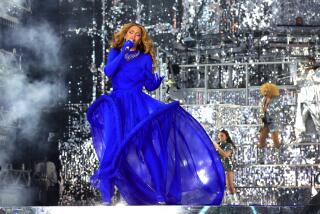Restored ‘Lawrence’ Conquers New York Premiere Audience
- Share via
NEW YORK — A capacity crowd braved freezing temperatures here Saturday night to bask in the sun-scorched glories of the kind of film making that Hollywood doesn’t do anymore.
The black-tie premiere for the newly restored “Lawrence of Arabia” culminated an epic struggle to locate, repair and re-edit footage that began disappearing within weeks of the film’s initial release, back in December, 1962.
It was the first of three premieres marking the film’s re-release. Sunday’s Washington premiere was held at the Cineplex Odeon Circle Avalon Theater. And the Los Angeles premiere will be held Sunday at the Cineplex Odeon Century Plaza, where the film officially opens Feb. 15.
Hacked-away over the years, first so that exhibitors could squeeze in more screenings, then so that television could squeeze the movie into a time slot (and squeeze its sprawling 70-millimeter images into a TV format), “Lawrence”--winner of seven Academy Awards, including best picture--acquired a kind of legend through the years, becoming a cause celebre among film historians/lovers.
The thunder of applause that greeted the film’s latest adventure would seem to signify that the saga of T. E. Lawrence, the unlikely hero who helped to unite Arab tribesmen in their battles against the Turks, is once again off and riding.
Restored to director Sir David Lean’s original cut, the 3-hour, 40-minute “Lawrence” mesmerized the crowd that filled the more than 1,200 seats of the Art Deco-studded Ziegfeld Theater on West 54th Street.
Adding to the night’s excitement: the presence of Lean himself, and his two once-unknown stars, Peter O’Toole and Omar Sharif.
Also on hand were Oscar-winning editor Anne V. Coates (who wore a purple, rhinestone-studded Middle Eastern caftan “especially for the occasion”) and Oscar-winning cinematographer Freddie Young.
The night’s other VIPs included Robert A. Harris and Jim Painten, producers of the restoration; film makers/restoration-preservation advocates Martin Scorsese and Steven Spielberg; and Columbia Pictures President Dawn Steel. (It was Scorsese and Spielberg who convinced Steel that the studio should back the restoration.)
For O’Toole, the night marked the opportunity to “see my old chums again.” (With understated aplomb, O’Toole said, “This is all awfully nice.”)
With a nod to yesterday’s epic motion pictures, O’Toole added, “We’d make them tomorrow if we could.” He smiled at Sharif as he quipped, “Just think--if we did ‘Lawrence’ again, I could play the Alec Guinness part and he could play Tony Quinn’s role.”
For Sharif, it was his first “Lawrence” screening since 1962. “I can still remember that very first premiere in 1962. Then I was so nervous. I had no way of knowing how the audience would react. Would they like the picture? Would they like me?”
“I feel like I’m seeing an old friend I haven’t seen for a long, long time,” said a jubilant Lean. The seriousness of the night was echoed by Scorsese and Spielberg. Said Scorsese: “This is not a film that was made in 1925. It’s not a movie no one has ever heard of. This film is a legend. It won Oscars. It has stars who have become household names. And there are moments from this film that people associate with those stars.” He sighed: “That a movie like ‘Lawrence’ could have deteriorated so quickly. That is truly alarming.”
American Film Institute director Jean Firstenberg introduced the “Lawrence” participants as they lined up in front of the theater’s massive gold curtains. “We are in the midst of film history tonight,” she exclaimed.
Underwritten by Columbia, the film’s three premieres will benefit the AFI’s film preservation efforts.
“Lawrence” will play only New York, Washington and Los Angeles to begin with. The reason: prints are costly (just under $40,000 each) and few modern theaters are capable of showing a film of “Lawrence’s” wide-screen scope.
Little wonder then that Lean created a stir among the Ziegfeld audience when he kicked off the screening by looking at the theater’s massive screen, and proclaimed: “This is what the movies should be shown on.”
That said, the overture began. (The film’s stirring score earned Maurice Jarre an Academy Award.) So did the applause. It grew thunderous when Lean’s name appeared. There was applause, too, for the stars’ credits--as well as an audible gasp when the words “And introducing Peter O’Toole” appeared.
The “Lawrence” celebration continued later that night, as a crowd of 600 (who had paid $250 to $1,000 a ticket) gathered for a dinner in the Grand Ballroom of the Pierre Hotel.
There were lots of starry names among the crowd, including Sylvester Stallone, Christopher Reeve, Jane Alexander and Donald Sutherland.
New York Mets’ first baseman Keith Hernandez was there, too--signing autographs and searching for some himself.
Carrying his 1962 souvenir “Lawrence” movie program, Hernandez worked the room getting the movie’s cast and crew to sign it. “I got it when I first saw the film. I was about 9. I never, ever forgot it,” said Hernandez. “I couldn’t wait to see this movie again.”
“Lawrencemania” also struck Manhattan Beach attorney Rick Lesser, who came with his 5-year-old son, Ricky (who wore a little tux). “I spent $250 a ticket--and Ricky isn’t subbing for anyone,” Lesser said. “I really wanted him to be a part of this night. I still remember the first time I saw ‘Lawrence.’ It was magic.”
As for what the movie magic means to the modern studio executive, Dawn Steel was upfront: “I’m not about to compare ‘Lawrence’ with any of our other (upcoming) titles. That wouldn’t be fair.”
Added Steel: “With this movie, you’re talking about perfection--or as close to it as you can get. You just don’t get better than David Lean.”
More to Read
Only good movies
Get the Indie Focus newsletter, Mark Olsen's weekly guide to the world of cinema.
You may occasionally receive promotional content from the Los Angeles Times.










